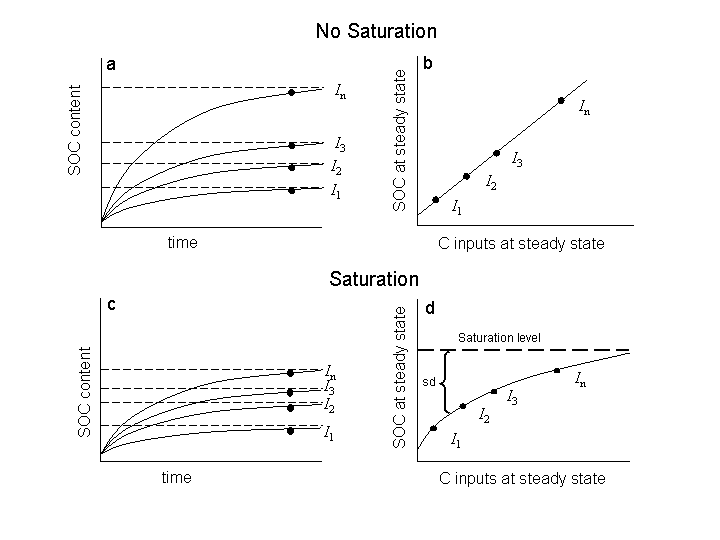
Monday, 10 July 2006
15-4
Theory and Evidence of Soil C Saturation using Long-term Agroecosystem Experiments.
Catherine Stewart1, Keith Paustian1, Rich Conant1, Alain Plante2, and Johan Six3. (1) Natural Resource Ecology Laboratory, Colorado State Univ, Fort Collins, CO 80523-1499, (2) Dept of Biology, Villanova Univ, 800 Lancaster Avenue, Villanova, PA 19085, (3) Dept of Plant Sciences, Univ of California-Davis, One Shields Avenue, Davis, CA 95616
Current estimates of soil C storage potential are based on models or factors that assume first-order decomposition kinetics and hence linearity between C input rate and C stocks at steady-state (See Figure). However, soil C stocks may be inherently limited by physicochemical soil characteristics such as texture and structure, which define a whole-soil C saturation limit (See Figure). Direct corollaries of a whole-soil C saturation concept are that the further a soil is from saturation, (i.e., the greater the saturation deficit (sd; See Figure)), the greater its capacity to sequester added C and as a soil approaches saturation, the rate of SOC accumulation decreases due to a smaller saturation deficit. We used long-term agroecosystem data to 1) compare two C saturation models (i.e. a one pool model and a two pool model) to the standard first-order linear model and 2) ascertain the effect of saturation deficit on soil C accumulation. Within a given site there was little additional support for C saturation models over the linear model due to small sample size and strictness of our model selection methods. However, across all sites, the one pool C saturation model had the best fit and therefore corroborates the C saturation concept. We also suggest that disturbed (e.g. tilled) soils may approach an effective stabilization capacity that is influenced by saturation dynamics, but disturbed soils cannot obtain a true C saturation limit due to increased C losses through decomposition. The ratio of no-till to conventional-till SOC across increasing soil C contents decreased log-normally, suggesting that C saturation deficit influences the rate of soil C stabilization in no-till systems. This trend was evident in both temperate and tropical soils, although the tropical sites had a steeper decline. The latter is probably due to the dominance of more weathered minerals with a lower C stabilization capacity. The true soil C saturation level of a soil may be of small practical importance, as large organic C inputs must be maintained over long time periods to sequester a significant amount of C. Of more practical interest is the behavior of soils as they approach their effective stabilization capacity as well as the influence of C saturation deficit on SOC accumulation in non-saturated soils. We conclude that SOC sequestration rates may be overestimated by models with kinetics that yield linearity between C inputs and C stocks at steady-state.

Back to 2.2A Soil Organic Matter: Stabilization and Carbon Sequestration - Theater
Back to WCSS
Back to The 18th World Congress of Soil Science (July 9-15, 2006)